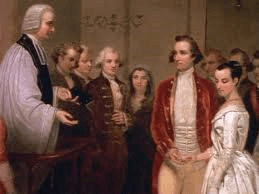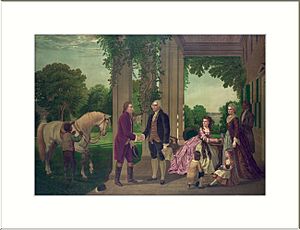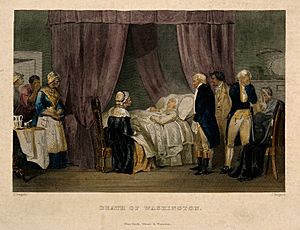Caroline Branham facts for kids

Caroline Branham (1764–1843) was an enslaved housemaid and seamstress who worked for George and Martha Washington. She was married to Peter Hardiman, who was a groom hired by Washington. Caroline and Peter had eight children together. Her ninth child, Lucy, is believed to have had George Washington Parke Custis as her father. Caroline helped the Washington family and their many guests feel comfortable in their home.
She was with George Washington when he died in 1799 and with Martha when she died in 1802. After Martha's death, Caroline became the property of George Washington Parke Custis, Martha's grandson. In the 1820s, a historian named Jared Sparks interviewed Caroline for a book about Washington. She agreed to the interviews in exchange for her grandson, Robert H. Robinson, being set free. Robert was Lucy's son and was freed at age 21 after working as an apprentice for eleven years.
Contents
Caroline's Early Life
Caroline Branham was born into slavery in 1764 at Mount Vernon, which was George Washington's plantation. Her mother was enslaved by Daniel Parke Custis, who died in 1757. Martha Washington, Daniel's wife, received control over one-third of his property, including enslaved people, for her lifetime. This meant Caroline was part of Martha Washington's "dower estate." After George and Martha married in 1759, Caroline was effectively owned by both of them.
Working as a Housemaid and Seamstress
Caroline started her work each day before sunrise and continued after sunset. She and other housemaids, like Molly and Charlotte, kept the Washingtons' mansion and other buildings clean. Early in the morning, she would light fireplaces to warm the rooms before the family and guests woke up. Her tasks included washing clothes and linens, dusting furniture, cleaning floors, and other household duties.
She also took care of family members and visitors. This meant using bed warmers on cold nights, providing water for washing, emptying chamber pots, lighting fires and candles, and making beds. A bell system helped summon the house workers to different parts of the mansion. Sometimes, Caroline helped get the mansion ready when the Washingtons returned from Philadelphia.
I beg you will make Caroline put all the things of every kind out to air and Brush and Clean all the places and rooms that they were in…
—Martha Washington to her niece Fanny, June 1794
Mount Vernon often had many visitors. George Washington once said that his home was like a "well resorted tavern" because guests stayed overnight about two-thirds of the time. He noted that "scarcely any strangers who are going from north to south, or from south to north do not spend a day or two at it." The Washingtons offered comfortable rooms with nice furniture, china, soap, wine, and other foods. Housemaids like Caroline prepared these rooms with fresh linens and water for washing. They also emptied chamber pots and wash basins.
Caroline was also a seamstress. She made clothes for the enslaved people on the Washington plantation. Women who worked in the mansion, like Caroline, wore long dresses made of simple fabric. They also wore aprons, shoes, stockings, and caps over their hair, especially when they were around the family or visitors.
Sometimes, Caroline showed quiet resistance to being enslaved. She might work slower or not finish tasks as quickly as expected. The Washingtons sometimes threatened to make her work in the fields, but they never did. They valued skilled household workers like Caroline and worried about making them angry. Even though slaveholders had power over enslaved people's lives, valuable workers like Caroline could sometimes negotiate for better conditions for themselves and their children.
George Washington was always concerned about being taken advantage of. He worried that Caroline might keep fabric scraps for mending clothes or making quilts. He also thought Peter Hardiman took too long when traveling between the five farms at Mount Vernon.
Serving the Washington Family
When George and Martha married, Martha had two children from her first marriage: John ("Jacky") Parke Custis (1754–1781) and Martha ("Patsy") Parke Custis (1756–1773). These children became George Washington's stepchildren. Patsy died as a teenager. Jacky married Eleanor Calvert in 1774. They had three daughters and a son. When Jacky became an adult, he received a large inheritance from his father's estate and became Peter Hardiman's owner.
Jacky died in 1781. His wife, Eleanor, then controlled his estate for her lifetime. Hardiman would drive Eleanor from her home, Abington plantation, to Mount Vernon to visit Martha and George. During these visits, Hardiman met Caroline, and they fell in love. At first, they could only see each other when Eleanor visited Mount Vernon.
Eleanor married Daniel Stuart in 1783. Her two oldest children, Elizabeth Parke Custis and Martha Parke Custis, lived with the Stuarts. Eleanor Parke Custis and George Washington Parke Custis went to live with George and Martha Washington.
From 1775 to 1783, George Washington was the leader of the Continental Army and was away from Mount Vernon. In 1789, George Washington became President of the United States. The Washingtons visited Mount Vernon sometimes during his eight years as president.
Making Mount Vernon Self-Sufficient
After George Washington stopped being the commander-in-chief in 1783, he returned to Mount Vernon. He wanted to make the estate self-supporting, meaning he wanted to produce everything they needed right there. If a special skill was needed, he would hire or rent enslaved or indentured servants. Mount Vernon had mills for corn and wheat, and a blacksmith shop where iron tools were made. Bricks, buckets, and barrels were also made on the property. Thread was spun and woven into fabric, then sewn into clothes by seamstresses. Leather was treated, and shoes were made. Fish were caught in the spring. The plantation also had a dairy, a distillery, and carpenters. Washington hired Hardiman to live at Mount Vernon and take care of the horses and other animals.
George Washington's Death
George Washington became very sick on December 14, 1799, and died that evening. Washington's lawyer, Tobias Lear, wrote that Caroline Branham and three other enslaved people were in his room when he passed away. In a picture of Washington's deathbed, Caroline is shown behind the foot of the bed. Her oldest son, Wilson, became a groom like his father. He was about 14 when he led Washington's horse, without a rider, in the funeral parade on December 18, 1799.
When George Washington died, there were 317 enslaved people at Mount Vernon. In his will, he said that 123 of the people he owned should be freed after Martha's death. Martha decided to free them earlier and signed a document in December 1800. They were freed on January 1, 1801.
However, 153 enslaved people that Martha brought to the marriage remained enslaved. Caroline and her children were among these "dower slaves." Washington had wanted to free the enslaved people from the Custis estate, but a law about dower slaves prevented him from doing so. He also could not find buyers for them.
Martha's Maid
Martha Washington supervised the household servants. This included locking and unlocking the kitchen and storerooms at night to prevent theft. Caroline was Martha's personal maid and was with her when she died. After Martha's death, the dower slaves were divided among her grandchildren, as her own children had already passed away.
Life at Arlington House
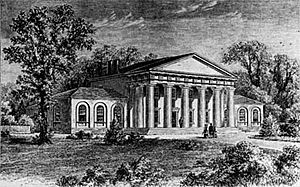
Martha Washington died in 1802. Caroline Branham and her children, along with Peter Hardiman, became the property of Martha's grandson, George Washington Parke Custis. Hardiman continued to care for Custis's horses, mules, and donkeys.
The Branham–Hardiman family lived in a small house on the Arlington House estate. Christopher Sheels, another enslaved person from Mount Vernon, also moved to Arlington House.
Around 1806, Caroline gave birth to a daughter named Lucy. It is believed that Lucy's father was Custis, based on research for the Mount Vernon exhibit Lives Bound Together. Custis's daughter Mary Anna married Robert E. Lee at Arlington House while Caroline lived there.
Caroline's Personal Life
Marriage to Peter Hardiman

By 1787, Caroline was married to Peter Hardiman, who was a groom for George Washington. Peter was enslaved by David Stuart. Washington rented Hardiman from Stuart starting in 1785, paying £12 per year. Washington wanted Hardiman to take care of his "Jacks, Stud Horses, Mares, etc." Managing the stables meant Hardiman could live with his wife and children at Mount Vernon.
Hardiman took care of racehorses, including Magnolia, an Arabian stallion, and Leonida. Washington sometimes lent Hardiman to friends to prepare their horses for races. Washington also wanted to breed good mules because they were useful farm animals. In 1785, he received a donkey named Royal Gift from the King Charles III of Spain. He received another from the Marquis de Lafayette named Knight of Malta. Hardiman then managed a large-scale mule breeding operation for Washington. He also bred horses and oversaw all stable activities.
He managed the health of the animals, such as during a sickness among the mares and young mules in 1790. Besides Washington's horses, Hardiman also cared for visitors' horses. Other enslaved workers helped feed, groom, and breed the animals. They also cleaned saddles and harnesses. Manure was collected and used as fertilizer on the farm.
Caroline's Children
By 1788, Caroline and Peter had two young children, Wilson and Rachel. They later had a total of eight children together, including Jemima, Leanthe, Polly, Peter, Austin, and Daniel. Her ninth child, Lucy, was born around 1806. Lucy was likely fathered by Custis and was said to look like Custis's daughter Mary. Custis also had children with another enslaved woman named Arianna Carter.
Like other enslaved people, Caroline and Hardiman were considered property. Children born to an enslaved mother were also born into slavery and belonged to their mother's owner. Until they were about eleven years old, children spent their days playing and looking after each other. They also did chores their parents assigned. Caroline's and Charlotte's children were known to play in the yard near the mansion. To protect the landscaping, Washington moved enslaved families further from the mansion by 1793. After that, only the cook's and butler's children could play in the mansion yard. At age eleven, children at Mount Vernon became part of the workforce.
Negotiating for Her Grandson's Freedom
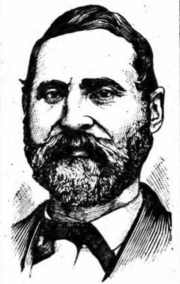
In the 1820s, Caroline Branham agreed to detailed interviews with historian Jared Sparks. Her condition was that her grandson, Robert H. Robinson, who was a toddler at the time, would be freed. Sparks was researching for a book about George Washington. Robert, Lucy's son, was bought in 1827 by Robert H. Miller, a Quaker. In 1834, Robert was apprenticed for eleven years to Robert Jamieson, a baker in Arlington. Robert was freed in January 1846, when he was 21 years old. The Robert H. Robinson Library was named after him.
Caroline's Death
Caroline Branham died in 1843. She was buried on March 13, 1843, in Alexandria, Virginia, in the graveyard of Christ Church. There was no marker for her grave or for any other African Americans buried there at that time.
Caroline in Popular Culture
Caroline Branham was shown in two documentaries: I Ain't No Three Fifths of a Person: Slavery and the Constitution and Hear My Story: The Enslaved Community at Mount Vernon.
See also


